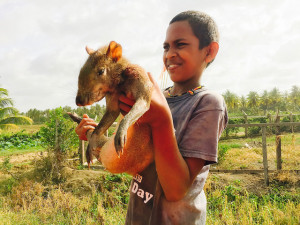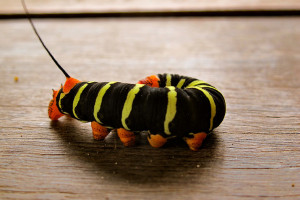
By Deanna Ramsay, originally posted at CIFOR’s Forests News
For many living in rural parts of the world, hunting wild animals offers both a vital source of protein and extra cash. In Cameroon, that work can result in additional annual income of €80, according to a recent study.
Defined by the Convention on Biological Diversity in 2011 as, “The harvesting of wild animals in tropical and sub-tropical countries, for food and for non-food purposes,” bushmeat hunting is simultaneously mundane and a hot topic.
In a keynote speech titled “Wildlife: A forgotten and threatened forest resource” at the annual Association for Tropical Biology and Conservation (ATBC) meeting, CGIAR Research Program on Forests, Trees, and Agroforestry director Robert Nasi discussed the bushmeat issue in the Congo and Amazon basins.

With the recognition that millions around the world use wild animals for food and income, and that such practices can negatively impact biodiversity, researchers are focusing on the extent of people’s dependence, looking at quantifying matters such as wildlife harvest numbers, consumption amounts and the accrued financial benefits.
Round numbers
Generating appropriate data on extraction from the wild helps elucidate the importance of wildlife for poor people, as well as contribute to necessary conservation work.
“Some groups argue that conservation of areas is bad for local people. It is possible to achieve a balance, but better data are required to establish how both protection of biodiversity and the needs of people can be made compatible,” said John E. Fa, a senior research associate at the Center for International Forestry Research (CIFOR) and coordinator of CIFOR’s Bushmeat Research Initiative.

Better access to information and research data is required across fields and disciplines. Taking this into account – and that for hunting what little information available is dispersed – there is now a resource that collates datasets on subsistence hunting and related practices from around the globe called OFFTAKE.
“Bushmeat research has been mainly site specific and gathered by NGOs and academics. This data needed to be brought together, and we are continuing to add to it,” she said during her talk, which focused on bushmeat consumption figures in Central Africa.
In recently published research in International Forestry Review, seconded CIRAD scientist at CIFOR Guillaume Lescuyer and Robert Nasi looked at another side of the bushmeat equation, determining the financial (i.e. trade) and economic (i.e. self-consumption) benefits derived from bushmeat from the full range of actors in Cameroon.
There are an estimated 552,000 people in the country who hunt for income, subsistence and a combination of both. Lescuyer and Nasi calculated a net financial benefit of hunting in rural areas as €10 million a year and a net economic benefit of €24 million.
“People have not been that interested in the question of quantifying the importance of bushmeat. That is why we decided to do a financial analysis – this has not been done before in Cameroon, and our findings are powerful,” Lescuyer said.
Win-lose?
Lescuyer and Nasi found that local hunting was rewarding, with a profit margin of approximately 22 percent. They also determined that the annual turnover of the bushmeat sector is much higher than previous official assessments at close to €97 million, with the contribution to Cameroon’s GDP as substantial as the mining sector.
Equipped with figures indicating the economic significance of the practice for the rural poor and local and national economies, the question emerges – are such practices sustainable?
Some say no. But, as bushmeat discussions can revert to familiar debates that position conservation against livelihoods, numbers, again, are vital. Having studied bushmeat for decades, Fa said measuring sustainability is a difficult task.
“One problem is we know very little about tropical animals and their biology, including reproduction. Even if you have abundant data on the species out there you also have to know the fluctuations in how many animals a hunter gets per day,” he said. And, the consumption figures that emerge often vary in comparison to extraction numbers. These discrepancies mean more studies on tropical animals and human practices are needed, Fa said.
Too legit
Honoring both concerns, researchers are recommending a combination of on-the-ground changes and government policy steps. “Up to 80 percent of rural households in central and western Africa depend at different levels on bushmeat for their daily protein requirements and essential income. A blanket ban on the trade would endanger both humans and wildlife,” Nasi said.
Developing alternative protein sources in rural areas, working to reduce demand in urban areas and enforcing bans on exports has been advised. “Alternative meats could be a good way of deterring people from eating bushmeat, but that is more likely in big cities because they don’t rely on it,” Fa said. Fostering the consumption of other proteins is a long-term goal, but addressing urban consumption is key in the short-term, Lescuyer said.
At ATBC in Montpellier, Nasi discussed the problem of bushmeat exports to Europe, advocating for better law enforcement. “You can walk five minutes from here and I can bring you back a duiker leg from a small grocery. There is no reason why anyone in Europe should be eating bushmeat.”
For researchers, it is time to use the hard numbers and data emerging to clarify a complex issue. “There has been a one-way view for the last 25 years without success. It is time to try something else. It is time to legitimate the debate around bushmeat,” Nasi said.











